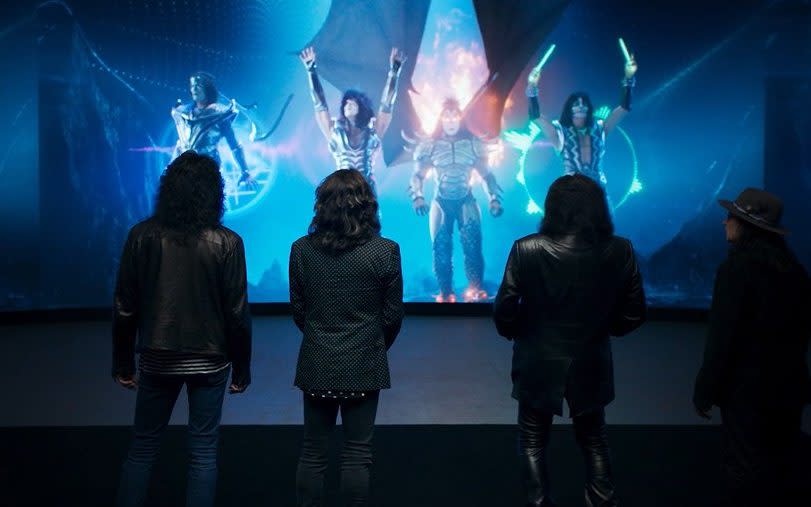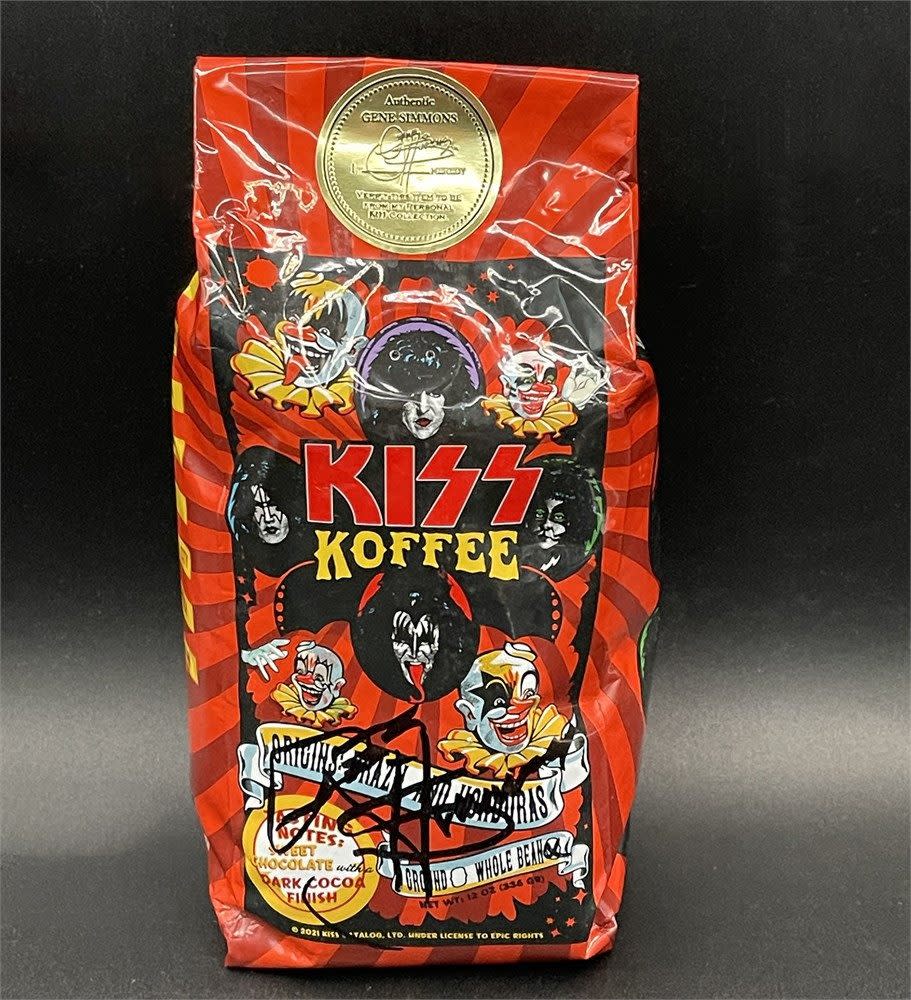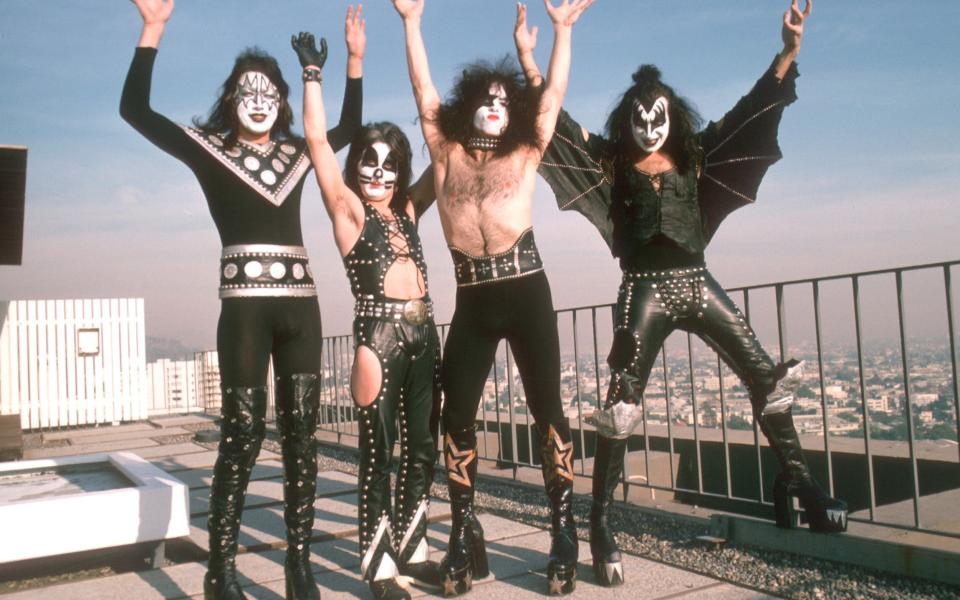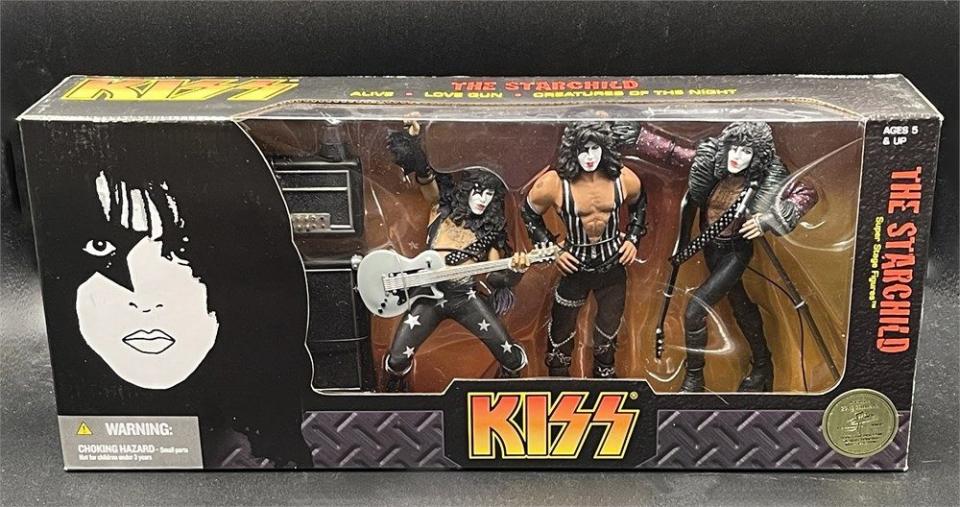Marketing monsters of rock: How Kiss made millions from ‘air guitar strings’

- Oops!Something went wrong.Please try again later.
- Oops!Something went wrong.Please try again later.
Of the hundreds of bands I’ve interviewed over the years, only one has asked me to snap on a pair of latex gloves. This was Kiss, by which I mean lead singer and rhythm guitarist Paul Stanley and bassist and co-vocalist Gene Simmons, back when they were on the stump for an item of merchandise only they could produce. Standing 3ft tall, the Kiss Monster Book, published in 2012, retailed at an eye-popping $4,250. I had to put on the surgical gloves before I was even allowed to touch it.
More than any other band – more than the Stones, even – Kiss are the true pioneers of music marketing. Despite bowing out from the concert circuit following two concerts at Madison Square Garden in December of last year, one suspects (or fears) that these rockers will never truly die. Certainly, the group’s recent decision to sell their music and branding rights to the Stockholm-based Pophouse group, the company behind the Abba Voyage residency in London, clears the path for the New York rockers to live on in digitised form.
“If you take a look at Mother Nature, you either evolve or you become extinct,” Simmons said recently. “The beginning of [new] Kiss is going to be something that will blow your socks off, like nothing you’ve ever seen.” As if by magic, the bassist then turned into Pinocchio. “It’s not about [the money],” was his response to a question about the $300 million paid to him and Stanley by Pophouse.

Of course, for Gene Simmons and Paul Stanley, it’s always been about the money. When it comes to selling the sizzle rather than the steak, the pair’s business acumen borders on genius. In the 15 years that followed a hastily rescinded retirement in 2001 – don’t ask: Kiss have come back from the dead more times than Boris Karloff – the band grossed more than $500 million from merchandise sales alone. They didn’t stop at cotton, either. For a group who would stick their logo on an air ambulance if it flew past low enough, the possibilities were endless.
Since forming in New York City, in 1973, Kiss have licensed their name to more than 5,000 products. We’ve had Kiss condoms, action figures, comic books, cartoons, credit cards, board games, pinball machines, branded coffee (“Koffee”), memorial prayer cards, pet-cremation urns, and more. At the start of the century, prospective customers with an eye for long-term eventualities were even able to buy coffins emblazoned with the group’s name (”Kiss Kaskets”, they were called) for a mere $4,500. Brothers Vinnie and Darryl “Dimebag” Abbott, from the Texan metal band Pantera, did just that, and were duly buried in them. (Alas, this most tasteful item has since been discontinued.)
If I had to choose, though, I think my favourite product from a band never knowingly oversold was a line of “air-guitar strings” that was in fact an empty packet of clear plastic beneath a cardboard strip bearing – but, of course – the Kiss logo. A price-tag of $4.99 meant the product was seen as a good-natured joke rather than a rip-off. In the run up to Christmas in 2017, the band are said to have made a fortune from this one item alone.
“I certainly never bought into this idea of being a dumb rock musician who at some point goes, ‘Where’d all the money go?’” Paul Stanley told the Financial Times in 2019. “I’ve always believed that as talented as you may be at making money, there’s probably someone who’s just as talented at taking it. So it always made sense to me to monetise what we do. There’s a difference between being an idealist and a realist, and the difference is age. The whole idea of a starving artist, or the idea someone isn’t interested in money – well, guess what, you will be when the rent [is] due.”
The prospect of the band living on in digitised form will come as no surprise to their core constituents, or perhaps to anyone. In Manhattan, as Kiss left the stage after bidding their fans goodnight for the last time, the four members were replaced by onscreen avatars for the song God Gave Rock ’n’ Roll To You II. As the reviewer Michael Sun correctly noted, “They used their encore to debut their afterlife”.
To be fair, no group is better suited to this kind of treatment. Under cover of make-up, Kiss were cartoon characters rather than human beings. Their shtick is an aspirational ideal for an attentive fan-base who rather fancy the notion – but only the notion – of being able to rock and roll all night, and party every day. By comparison, the real lives or the real people people behind the greasepaint aren’t important. When original members Ace Frehley (lead guitar) and Peter Criss (drums) left the group for a second time, in 2002 and 2004 respectively, Stanley and Simmons bought the rights to their distinctive make-up so that surrogates could take their place with minimum fuss.

They’re not slow when it comes to guarding their turf, either. In the late 1980s, the histrionic Danish metal singer King Diamond was forced to alter the look of his own face paint after Gene Simmons threatened to sue for copyright infringement. (“I was never influenced by them,” he complained, after doing as he was told. “My influences were Peter Gabriel and Alice Cooper.”) Elsewhere, Simmons gave predictably short shrift to criticisms that his band were shills rather than artists. “Yeah, we sell out,” he told the VH1 series Behind The Music. “We sell out [our concerts] every night.”
Actually, though, that’s not always been true. The decision in 1983 to remove the make-up, in time for that year’s Lick It Up album, began a 13-year slide into commercial and cultural ordinariness that strongly suggested the band’s music wasn’t all that interesting when separated from the allure of mysterious anonymity.
Sure, the 1980s and early 1990s saw hits such as Crazy Nights and God Gave Rock ’n’ Roll To You II, but the foot-soldiers of the Kiss Army were thinner on the ground than in years past. During my adolescence, it seemed that every review I read of concerts in American arenas during this time mentioned venues that were far less than full.

The decision in 1996 to once again slap on the slap was motivated by the band’s usual instinct for giving people not only what they want, but what they’ll pay for. “We just shrugged our shoulders [and did it],” Gene Simmons reported. It would be quite wrong to suggest that Kiss pretended their 13-years without greasepaint never happened, or were a dream, but it was understood by all that these were not the glory years. Of the 23 songs played at Madison Square Garden, only two were from this period. Their creative engine then packed up completely. Of the two studio albums released by the group in the 21st Century, the most recent (Monster) is 12 years old.
“If you were to put on a live McCartney concert video, or the Stones, and turn the sound off, I could tell you every time they’re playing a new song, because the audience sits down,” said Paul Stanley in 2019. “The idea of creating new music is not of much interest to me.”
Before the cynicism set in, though, Kiss were like Willy Wonka. Their imaginations were magical. In 1975, for example, hundreds of thousands of people entered a competition to win one of five photographs of the group without make-up. The only problem was that once these pictures had been freed from their protective wrapping, the image of the band sans slap faded to grey after just five minutes. Dizzy with admiration, Tony Wilson, the great Mancunian impresario, described it as a “fabulous, fabulous piece of marketing”.

“We all love Springsteen, and I’ve admired him for generations,” Gene Simmons told the writer Michael Hann, in 2019. “But don’t f______ kid yourself. Just because someone tears their jeans just so and doesn’t want to be seen driving around in a Rolls Royce doesn’t mean they don’t like that. I simply refuse to play the game. Putting together the band, part of it was, ‘Gee, wouldn’t it be great to make lots of money and get chicks?’ Trust me, whether you’re Leonard Cohen or Bob Dylan, they still like the money and the chicks. Don’t kid yourself.”
It may have taken them a while, but in the 21st century musicians have at last bought into the Kiss philosophy. As well as charging hundreds of pounds for tickets, and thousands for backstage “meet and greets”, Metallica have licensed their name to high-end watches and bottles of vodka. The Pogues have their own line of whiskey. Nashville rockers Kings Of Leon and the Canadian alternative singer Grimes are just two of many artists who have made a packet out of the burgeoning NFT [Non Fungible Tokens] market. With songs and albums becoming decreasingly profitable, artist-adjacent branding is the new rock and roll.
But it was Kiss who got there first. Consistently derided for their music, in the fullness of time, their flair for business has made them one of the most influential bands in the history of rock and roll. As Gene Simmons once told Forbes magazine, “At the highest level [of the rock biz] you can make one hundred times more than the President of the United States, who makes around $400,000 a year. I make more than that in a night.”

